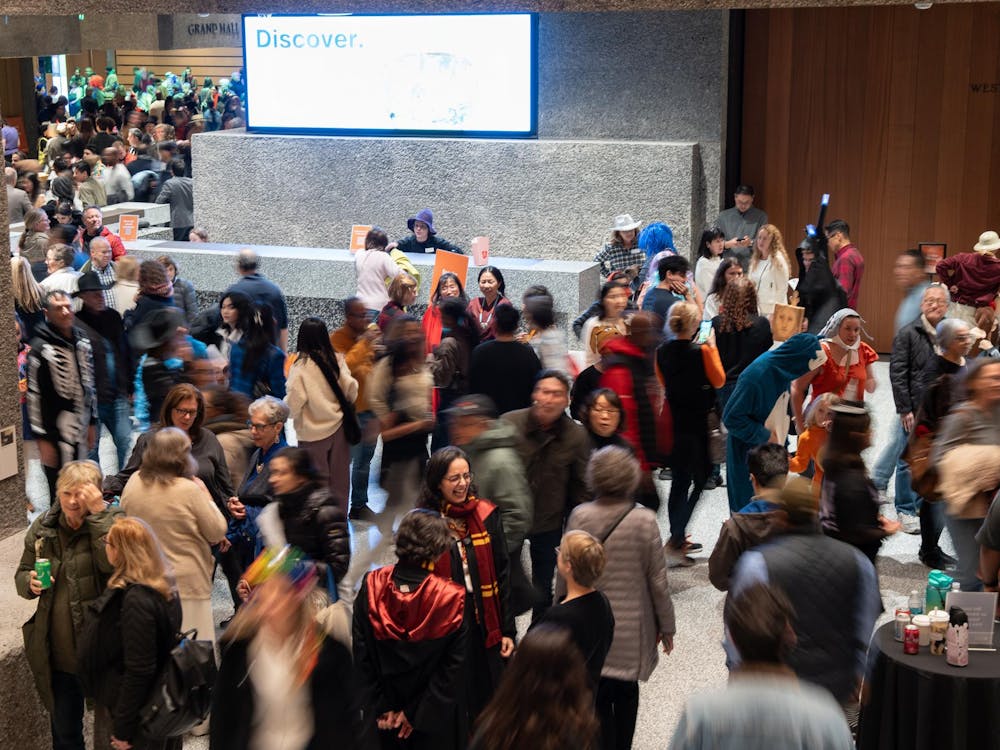Why scroll through Instagram reels during sneaky study breaks when you can stroll through beautiful, refined exhibits to clear your head instead? Since the opening of the new Princeton University Art Museum on Halloween, I explored several of its spaces to identify study spots that could potentially top my go-to cubicles at Firestone — and maybe even yours.
Grand Hall

Princeton University Art Museum’s Grand Hall.
Katharine Shea / The Daily Princetonian
The Grand Hall, located past the art museum’s gift shop on the first floor, is a vast and open space. There’s plenty of seating, perfect for chatting with friends or taking a break from peering at exhibitions. Miniature chestnut-and-taupe couches, some back-to-back, are placed throughout the floor. The couches, along with several mustard yellow-and-orange-cushioned chairs, are paired with small, marbled coffee tables in front of them.
Above, glass walls exhibit a portion of the museum’s collection of ceramic trinkets, sculptures, and porcelain items on shelves. Natural lighting emanating from the gridded skylight ceiling illuminates the room in the daytime. At the front, a large projector display mostly remains black and dormant, but occasionally portrays graphics.
While the environment is certainly relaxing, I would not consider Grand Hall an all-rounder study spot. Although the room is relatively spacious and offers comfortable seating options, you might be out of luck if you need a surface. The couches, while a good spot to write essays, are definitely not the space for you if you need a hard surface to physically write on. Not only are the coffee tables small, they are quite low — so you might risk a trip to Frist Health Center for back pain before finishing your p-set. The Grand Hall works if you prefer a semi-busy atmosphere and do not need a table to work on.
Outdoor Pavilion

Princeton University Art Museum’s Outdoor Pavillon.
Kaichen Chou / The Daily Princetonian
In my search for a better study space, I headed outside, where I was greeted with a series of green metal tables and chairs below the museum’s northwest cantilever. Along the edge, patio umbrellas shield the tables from harsh sunlight, adding a nice touch to the area’s overall appearance. While the chairs were slightly wobbly and are not the most comfortable to sit in — especially compared to the lush and full seating inside Grand Hall — the circular tables provided ample surface area to work on.
With a gorgeous autumn view of fall leaves and cycling students, studying felt relaxing and unrestrictive and provided a great change of scenery from the usual blank walls of Firestone’s basement. I also appreciated the ability to glance ahead and see the hustle and bustle of each passerby which made the space feel more lively and motivating.
While the pavilion area is an amazing choice for folks who desire fresh air while studying, it is worth noting that the outdoors may become a less practical option as we quickly approach winter with earlier sunsets. To this point, as I studied, the wind grew progressively more frigid, and the sunset at 5 p.m. cut my session short. For this reason, to maximize your study experience outside the art museum, take advantage of the warmer and sunnier daylight hours. Once spring rolls around, though, I can imagine the pavilion area being a reliable, productive location for me as well as many others.
Mosaic Restaurant


Mosaic Restaurant.
Kaichen Chou / The Daily Princetonian
As soon as I walked into the restaurant, located on the third floor of the museum, I was greeted by soft, natural lighting that permeated the room through translucent ivory curtains. The golden hour sun enveloped the room in rays of sunshine, creating a cozy environment ideal for work. At the front, a multi-colored tiled mosaic, paying homage to the restaurant’s name, contributed to the room’s luxurious essence. Brown square dining tables fill the space, topped with glass vases holding foliage.
Beneath the curtains, a dining table spanning the wall stood out to me as an ideal spot to study. The large glass windows ahead offered a beautiful view of Dod Hall and other nearby buildings. If you get hungry, Mosaic’s comprehensive menu offers a wide range of options, from desserts and baked goods to coffee, tea, and other beverages. While the prices of the main courses on their menu are steep, their desserts are quite reasonably priced and could serve as a convenient and affordable source of energy during long study sessions.
Although Mosaic appears to cater more to visitors than students due to some of its higher-end prices, the atmosphere is still comparable to that of any typical coffee shop, making it an optimal setting for getting work done. However, Mosaic closes at 3 p.m. on most weekdays and the weekend, and is closed completely from Tuesday to Wednesday — so be sure to keep an eye out for available times during your next study session.
In all, although the art museum provides enjoyable views and comfortable spaces, I still prefer Firestone for urgent assignments and longer study sessions. That being said, the new museum spaces offer a change in scenery that I, as well as many other students, will appreciate in the waning weeks of the fall semester.
Kaichen Chou, member of the Class of 2029, is a contributing writer for the Prospect and a copy staffer. She can be reached at kc2050[at]princeton.edu.








